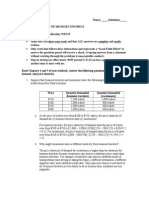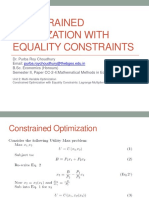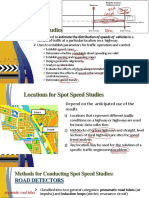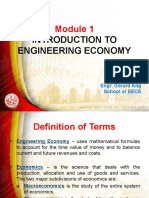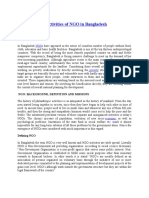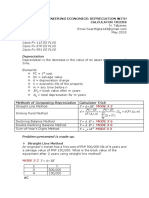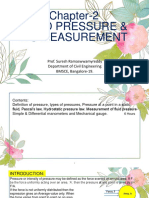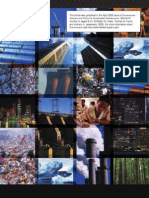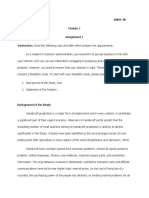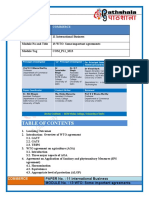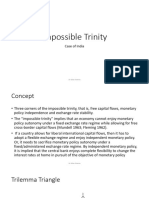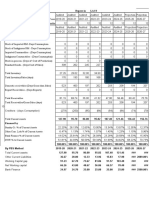0 ratings0% found this document useful (0 votes)
211 viewsChapter 4
Chapter 4
Uploaded by
Joshua de JesusThis chapter discusses the changing nature of the nation-state in the contemporary globalized world. It explores potential replacements for the traditional nation-state model, including regional alliances, international organizations, and non-state actors like multinational corporations and NGOs. The document also examines factors driving the emergence of global governance like the declining power of nation-states, vast flows of information, people and goods across borders, and issues like financial crises and human rights crises that individual states struggle to address alone. Finally, it analyzes challenges to state sovereignty from traditional sources like external intervention as well as national identity movements within states seeking greater autonomy.
Copyright:
© All Rights Reserved
Available Formats
Download as PPTX, PDF, TXT or read online from Scribd
Chapter 4
Chapter 4
Uploaded by
Joshua de Jesus0 ratings0% found this document useful (0 votes)
211 views65 pagesThis chapter discusses the changing nature of the nation-state in the contemporary globalized world. It explores potential replacements for the traditional nation-state model, including regional alliances, international organizations, and non-state actors like multinational corporations and NGOs. The document also examines factors driving the emergence of global governance like the declining power of nation-states, vast flows of information, people and goods across borders, and issues like financial crises and human rights crises that individual states struggle to address alone. Finally, it analyzes challenges to state sovereignty from traditional sources like external intervention as well as national identity movements within states seeking greater autonomy.
Original Title
CHAPTER-4 - Copy.pptx
Copyright
© © All Rights Reserved
Available Formats
PPTX, PDF, TXT or read online from Scribd
Share this document
Did you find this document useful?
Is this content inappropriate?
This chapter discusses the changing nature of the nation-state in the contemporary globalized world. It explores potential replacements for the traditional nation-state model, including regional alliances, international organizations, and non-state actors like multinational corporations and NGOs. The document also examines factors driving the emergence of global governance like the declining power of nation-states, vast flows of information, people and goods across borders, and issues like financial crises and human rights crises that individual states struggle to address alone. Finally, it analyzes challenges to state sovereignty from traditional sources like external intervention as well as national identity movements within states seeking greater autonomy.
Copyright:
© All Rights Reserved
Available Formats
Download as PPTX, PDF, TXT or read online from Scribd
Download as pptx, pdf, or txt
0 ratings0% found this document useful (0 votes)
211 views65 pagesChapter 4
Chapter 4
Uploaded by
Joshua de JesusThis chapter discusses the changing nature of the nation-state in the contemporary globalized world. It explores potential replacements for the traditional nation-state model, including regional alliances, international organizations, and non-state actors like multinational corporations and NGOs. The document also examines factors driving the emergence of global governance like the declining power of nation-states, vast flows of information, people and goods across borders, and issues like financial crises and human rights crises that individual states struggle to address alone. Finally, it analyzes challenges to state sovereignty from traditional sources like external intervention as well as national identity movements within states seeking greater autonomy.
Copyright:
© All Rights Reserved
Available Formats
Download as PPTX, PDF, TXT or read online from Scribd
Download as pptx, pdf, or txt
You are on page 1of 65
CHAPTER 4
The Global Interstate System
Introduction
The state has traditionally been the subject of the
most interest to scholars of global politics because it
is viewed as “the institution that creates warfare and
sets economic policies for a country.” Furthermore;
the state is a political unit that has authority over its
own affairs. In other words, its borders are recognized
by other countries. It’s assumed that whoever is in
charge of those borders has the right to determine
exactly what is going to happen in their country. The
treaty of Westphalia of 1648 established the notion of
the nation-state and the idea of the nation-state, state
sovereignty, government control and state policies
are challenged from all sides.
With globalization, some scholars suggest a
decrease in the power of the state and that other
actors are actually becoming more powerful. These
actors include multinational boundaries.
Is the idea of the nation-state outdated in
the contemporary world? If so, what is it that
we need to think about as “replacements”? In
this chapter, we will look at regional alliances
and word wide organisations of the states.
This manifests the efforts of the countries and
governments in the world to cooperate and
collaborate together. Next, international and
regional economic bond bodies, such as IMF
and the World Bank, must also be considered
as they often push for neoliberal reforms in
the world. The third kind of replacement to the
traditional nation-state and the idea of national
autonomy come from the non-state actors.
One of these is the private capital groups,
including banks and groups of people, with
money that can determine the well-being of
the people in a particular area. Multinational
corporations and non-governmental
organization, such as the amnesty
international, are significant organization that
put into question the strength of national
autonomy and global politics. The emergence
of non-state organizations, like Al-Qaeda, ISIS
and terrorist organization which seek power
try to dispose a government and replace the
system with their own ideological belief.
GLOBAL GOVERNANCE IN THE TWENTY-FIRST CENTURY
There is a series of specific factors
behind the emergence of global
governance. The first on the list on must
be the declining power of nation-states. If
states themselves were “highly contingent
and in flux” (Cerny, 2007, p.854), it would
open the possibility of the emergence of
some form of global governance to fill the
void.
A second factor is the vast flows of all sorts of things
that run into and often right through the borders of
nation-states. This could involve the flow of digital
information of all sorts through the internet. It is
difficult, if not impossible, for a nation-state to stop
such flow and in any case, it is likely that such action
would be politically unpopular and bring much
negative reaction to the nation-state involved in such
an effort. For example, china’s periodic efforts to
interfere with the internet have brought great
condemnation both internally and externally.
Then, there is mass migration of people and their
entry, often illegally, into various nation-states. If
states are unable to control this flow, then there is a
need for some sort of global governance to help deal
with the problem. The flow of criminal elements, as
well as their products (drugs, laundered money,
those bought and sold in sex trafficking, etc.), is a
strong factor in the call for global governance
(Levy and Sznaider, 2006). In these cases and
others, there is a need for some degree of order,
some sort of effective authority, and at least some
potential for the improvement of human life. These
are but a few of the things that can be delivered by
some form of global governance.
Another set issue that has led to calls for global
governance involves horrendous events within nation
states that the states themselves either foment and carry
out, or are unable to control (Nordstrom, 2004). For
example, in Darfur Sudan, perhaps hundreds of thousands
have been killed, millions of people displaced, and the
lives of many disrupted in a conflict that date back to early
2003. The government of Sudan and its military have been
implicated in the conflict between ethnic and tribal groups
and the Sudanese government has been resistant to
outside interference in its internal affairs. One could even
go back to WWII and argue that the Holocaust could have
been prevented, or at least mitigated, had there been a
viable form of global governance to put pressure on Nazi
Germany and ultimately, to intervene in a more material
way, perhaps militarily (Bauman, 1998).
Then, there are global problems that single nation-state
cannot hope to tackle on their own. One is the global
financial crises and panics that sweep the world
periodically, which nations are often unable to deal with on
their own (Strange, 1996). Indeed, some nations (e.g., the
nations of Southeast Asia) have often been, and are being,
victimized by such crises. Unable to deal with on their own
(Strange, 1996). Indeed, some nations (e.g., the nations of
Southeast Asia) have often been, and are being, victimized
by such crises. Unable to help themselves such nations are
in need of assistance from some type of global governance.
Nation-states have long struggled to deal with problems
like these through various interstate systems (e.g., alliances
such a NATO,) but the more recent trend is toward the
development of more truly global structures and methods of
dealing with various sorts of issues and problems.
EFFECTS OF GLOBALIZATION TO GOVERNMENTS
One of the key aspect of state sovereignty
is the government. It is a group of people who
have the ultimate authority to act on behalf of
a state. Each state has its own right to self-
determination and that other country should
not intervene in the affairs of that state unless
there are extraordinary reasons to do so.
Other countries must recognize sovereignty
or the right to govern ones own territory
borders. Each state is autonomous unto itself
and responsible within its own system of
government to those who are governed.
The decisions, the conflict, and the resolution
of that conflict are done through the
institutions of government established and
condified in that particular state, whether or not
through elections. Elections, especially in
democratic society, provide The leadership of
the State. In addition, the policy is developed
and implemented in the interest of the people of
a state by a specific government. A civil society
within a state can also act as a counterweight
or as a supplement to government. Civil society
includes the private economy, education
institutions, churches,hospitals, franternal
organization, and other non-profit organization.
There have been several challenges
to the government and ultimately, to
state autonomy.we can divide these
challenges into four: traditional
challenges, challenges from nation or
identity movements, global economics,
and global social movements.
TRADITIONAL CHALLENGES
External intervention can generally be described as invasion by
other countries. For example, when Saddam Hussein was the ruler of
Iraq in 1990, he decided he was going to take over the oil fields of
Kuwait. He invaded Kuwait and took it over. As a result, he was
dislodged by an international coalition led by the United States.
These days, we can see external intervention in other form.
Russia's external intervention into the affairs of Ukraine a sovereign
state in the post. Soviet era, is another instance of intervention in the
autonomy of the state. Russia intervenes in the affairs of people in
Cremia who wants to become part of Russia again even though they
are part of Ukraine. Cremia declared its independence from Ukraine
and re-affiliated with Russia. This is a case of how there might be a
national identity within a country that is assisted by a neighboring
country. Ukraine argues to have autonomy to determine the case for
Crimea. As a result, these is current conflict between Ukraine, not
recognizing Cremia's Sovereignty, and Russia, not recognizing
Ukraine's sovereignty over Crimea.
Internal political challenges can also happen. For
example, after the Arab Spring in Egypt, a new constitution
was created and a government was elected. The government
was more fundamentalist and rejected the notion of a plural
society that included religious diversity. The military staged
a coup that deposed the government in order to restore
stability. Other examples include the Taliban's efforts to
control the government of Afghanistan. In Syria, the original
rebellion against Assad came from the country's own
internal dissenters who wanted to replace the government
even though they were also Syrian nationals.
There are also regional organisations challenging state
autonomy. The United Nations intervened in Sudan because
of the several years of civil war. More recently in Europe,
specifically in Greece, it also interfered in the Greek debt
crisis.
CHALLENGES FROM NATIONAL/IDENTITY
MOVEMENTS
The next challenges are part of a national identity
or movement. It is important to know that a nation
has cultural identity that people attached to, while a
state is a definite entity due to its specific
boundaries. However, different people with different
identities can live in different states. Fo example,
the Kurds reside in several different countries
including Iraq, Iran, and Turkey. The catalans live
primarily in Spain but we can also find some of them
in France, Scottish nationalism is another example
that challenges the traditional notions of state
sovereignty.
In 2014, Great Britain had a vote in
Scotland to decide whether Scotland was
going to become its own autonomous state
apart from Great Britain. They voted against
it but Scotland has a significant degree of
autonomy now as compared to more than
two decades years ago.
Global movements, such as Al-Qaeda and
Isis, are another example of national or identity
movements. In this case, they are structured
around the fundamentalist version of Islam.
GLOBAL ECONOMICS
The third major source of challenge
comes from global economics. Global
economy demands the state to conform
to the rules of free-market capitalism.
Government austerity comes from
development of organisations that
cooperate across countries, such as
WTO and regional agreements, such as
NAFTA, the European Union and the
Association of Southeast Asian Nations
(ASEAN).
Neoliberal economics or neoliberal capitalism started
in the 1980s. It focuses on free trade and dismantling
trade barriers. It made sure that governments did not
impose restrictive regulations on corporate presence, as
well as on the free flow of capital and jobs. Free trade was
seen as the ideal or the normative belief, that is the best
economy is one where there is free trade everywhere.
Laws and standards that would interfere with the flow of
capital in a particular country, including environmental
regulations, were deemed to discourage economic
growth. Neoliberal economics requires a state to
cooperate in the global market through the feee flow of
capital, the privatization of services and fiscal austerity or
constraint. In turn, the government’s role is diminished as
it relates to the market. Neoliberal economics is seen as a
threat, in general, because a state cannot protect its own
economic interest as a sovereign state.
A specific example to expand global economic influence is the
use of IMF and the World Bank in forcing government reforms in
poorer country. Furthermore, the regional economic development
effort focused on expanding free trade and market liberalization.
Business from developed countries put their factories and pay
people to build factories and produce goods in developing
countries worldwide. These corporations will sell the products in
developing countries. This exacerbates rising inequality in the
world. Greece is one example that began in 1981 when Greece
joined the E.U. As a larger alliance, the EU broke down all kinds of
barriers among its member states, including Greece, like
passports, visas, and licence plates. It allowed people to travel
across European borders and encourage economic cooperation
and collaboration of member states. Twenty years later, Greece
adopted the euro as its own currency and got rid of the drachma.
The government if Greece borrowed money fir the infrastructure
improvements, largely linked to their hosting of the 2004
Olympics. This put Greece in a large debt. In 2007 and 2008, the
worldwide financial crisis made Greece’s economy to collapse.
Aside from high debt that burdened the
government, Greece had several if its employees
struggling with pensions. Tax revenues were lower,
and as a result, they could not pay their debts
back. In 2009, their credit rating dropped which
made it harder for them to pay bak their debt. This
led to a series if austerity packages in Greece
which meant that there was less government
spending. IMF bailed them out from the crisis in
exchange for more austerity. In conclusion,
economic crises can force government to
subscribe to the terms and conditions of the global
financial market and of other nations that can help
then regain economic stability.
GLOBAL SOCIAL MOVEMENTS
Finally, we have social movements. Most
of the time, they are not as a threat but
they definitely challenge state sovereignty.
Social movements are movements of
people that are spontaneous or that
emerge through enormous grassroots
organisation. These social movements are
transnational movements which means
they occur across countries and across
boarders. Therefore, state have less
control over them.
For example, human rights movements create a
public sentiment, value and agenda. The idea is that
there are certain rights that states cannot neglect or
generally, what we call human rights. If a country
decides that they are going to have a particular policy
and if that policy violates the international standard
of human rights, there is a challenge to the ability of
states to fully implement it. An example is the United
States' position on the death penalty. There is an
international consensus, with a few dissenting
countries like China, South Africa and Russia, against
the death penalty. This means that if somebody is
sentenced by death penalty and somehow he is in a
country around the world, there are rules against that
state extraditing into the United States.
The environmental movement is another example of
global social movements related to public policy. A specific
case is the so-called Blockadia or the state where social
movements emerging in local areas fight back as a
response to the controlling efforts by the apparatus of
government to protect the interest of neoliberal capitalists.
Consensus on women's right is another example in many
countries. Arguably, the biggest conflict between the west
and the fundamentalist islam is over the role of women in
society, as well as women's autonomy. Rights of personal
autonomy are another example and this includes on
homosexuality, same sex marriage and gender equality.
There is also an increase role in international organisation
like the United Nations and the International Criminal Court
in Hague, the role of non-governmental organisation like
Doctors without Borders or Amnesty International, and the
role of global media.
THE RELEVANCE OF THE STATE AMID GLOBALISATION
The state is a distinctive political community with its own
set of rules and practices and that is more less separate
from other communities.It has four elements: People,
Territory, Government, and Sovereignty. The first element
of a state is a permanent population .This population does
not refer to a nomadic people that move from one place to
other in an indefinite time ,this permanent. presence in one
location is strengthened by the second element of a state,
a defined territory, A territory has clear boundaries. A
territory is effectively controlled by the third element,
government. The government regulates relations among its
own people and with other states. This means that the
state is formally constituted sovereign political structure
encompassing people, territory, and its institution on the
one hand, and maintaining its autonomy from other state
on the other hand.
It is important to difference the idea of nation to
state. nation refers to a people. rather than any kind of
formal territorial boundaries or institutions.It is a
collective identity grounded on a nation of share
history and culture. If we talk about the Philippines as
a state,we may refer to the Philippine government, the
Philippine territory, and its internal sovereignty. if we
talk about the Philippine as a nation we refer to our
shared collective nation of democracy, our history,
and our collective identity,In other words, the state is
a political concept. State, through as formalised
institution more or less reflect nations. This would
allow state to have a certain people with their own
collective identity.In turn, they should be allowed to
form their own political state. this is a principle of
national self-determination.
This brings as to the concept of the nation-state. It
is a territorially bounded sovereign institution that
governs individuals sharing a collective history, and
identity and culture in reality, the Philippines,
although formally a state, has a variety of ethic
traditions.
A variety arguments are made including that
nation-states continue to be the major players on the
global stage (Gilpin, 2001),that they " retain at least
some power in the face of globalisation" ( Conley,
2002, pp 378-399),that they vary greatly in "their
efficacy in the face of globalisation" (Mann, 2007, p
472), and that the rumors of the demise of the
nation-state, are greatly exaggerated.
Beland (2008) argued that "the role of the state is enduring and
even increasing in advanced industrial societies" (p, 48). He saw
greater demands being placed on the state because of four major
sources of collective insecurity. terrorisms economic
globalisation leading to problems such as outsourcing and
pressures toward downsizing, as well as the current economic
crisis threats to nation identity due to immigration and the spread
of global diseases such as AIDs. further, the state does not only
respond to these threats ,may also exaggerate or create dangers,
thereby making its citizens more insecure (Glassner, 2000). A
good example is the U.S.A. and British government's arguments
prior to the 2003 war with Iraq that Saddam Hussein had weapons
of mass distraction (WMDs) that posed a direct threat to the
United State and United Kingdom. The United State even claimed
that Iraq could kill millions by using offshore ships to lob
canisters containing lethal chemical or biological material into
American cities (Isikoff and com, 2006). the collective insecurity
created by such outrageous claimed helped foster public opinion
in favor of invading Iraq and overthrowing Saddam Hussein.
The other side of this argument in support of the nation-state is
that global processes of various kinds are not as powerful as many
believe. For example, global business pales in comparison to
business within many countries. In addition, some question the
porosity of the nation-state by pointing, for example, to the fact that
migration to other countries has declined substantially since it's
heights in the late nineteenth and early twentieth centuries ( Gilpin,
2001).
A related point is that it would be a mistake simply "to see
globalisation as a threat to, a constraint on, the nation-state; It can
also be an opportunity for the nation-state" ( Conley, 2002, pp. 378-
399). For example, the demands of globalisation were used as bases
to make the needed changes in Australian society, specifically
allowing it to move away from protectionism and in the direction of
neoliberalization, to transform state enterprises into private
enterprises, and to streamline social welfare. With this, the rhetoric if
globalisation, especially ab exaggeration of it and it's effects, was
useful too those politicians who were hopeful of such changes.
INSTITUTIONS THAT GOVERN
INTERNATIONAL RELATIONS
There are several international
organisations that governments of
countries around the world and
individuals participate in. these include
the united nations, the international
court of justice, NAFTA, and NATO.
there are also non government
organisation promoting social and
economic growth. let us look at them
one by one.
Peace Treaties and Military Alliance: The UN and
NATO
Global politics entails relationship of countries
and different governments and non-governmental
organisations. The United Nations (UN) is one of the
leading political organisations in the world where
nation-states meet and deliberate. However, it
remains as an independent actor in global politics.
The premise for its establishment was the
restructuring of the world devastated after the
Second World War. The term "United Nations" was
coined by former U.S. President Franklin D.
Roosevelt in 1942 (United Nations, 2011). Its
operations began on October 24, 1945. It started with
50 representatives from different countries.
Generally, it functions in four areas: military issues,
economic issues, environmental issues, and human
protection. It is made up of close to 200 countries from
around the world, 193 member states to be exact, with
the Republic of South Sudan as its latest member
(United Nations,2011). The UN, with its headquarters in
New York City, was designed to be a place where
countries could come to discuss their issues without
resorting to violence and war, which had plagued our
planet for several years in the past. Maintaining peace
and building a friendships is the number one goal of the
UN, as well as providing a forum where countries could
gather to discuss global issues. The General Assembly
is the gathering of all of these countries. It is held in an
auditorium where speeches are given. Representatives
from different member states can vote on issues.
Maintaining international peace and security became
the central mission of the un after the war. Up to this
day, the UN is the major force in governing interstate
relations (Ritzer, 2015). According to the UN
(2011),peace and security are maintained "by working
to prevent conflict; helping parties in conflict make
peace; peacekeeping; and creating the conditions to
allow peace to hold and flourish." The UN also has
what is known as the Security Council. This group of
countries decides what to do when two or more
countries are waging war or are on the verge of
fighting. There are five permanent members of the UN
Security Council---the United States, Britain, Russia,
China and France. In addition to the five members, 10
additional countries join the permanent members for
two -year terms, making a total of 15 countries.
There's Security Council tries to be the arbiter in
ceasefires between two sides. They can pass
sanctions like block trade with another country as a
punishment. They can send troops or observers and,
if worst comes to worst, they can use military force.
In the past, UN peacekeepers have been sent to Africa,
Asia, and the Middle East. The "big five" permanent
members have a veto power, which means that one
member can stop that entire Council from taking
action against a country. This has come up recently
during the Syrian Civil War in which Russia and China,
who are allies with Syrian leader Bashar Al-Assad,
have been able to stop the other members from
stepping in to deal with the Syrian leader who was
accused of using biological weapons against his own
people.
The main deliberative body, they General Assembly,
provides a forum for member states to express their views
and reach a consensus. In 1991, the UN's military role was
put into question during its intervention in Iraq's invasion
of Kuwait wherein the Security Council authorised the use
of force (Ritzer, 2015). Aside from this, the UN intervened
in the Civil Wars of less developed countries, such as
Cambodia and Eat Timor, through "election and human
rights monitoring, disarmament and even the assumption
of state functions" (Weiss and Zach,2007).
The UN is not about fights. It has a program called
UNICEF or the United Nations Children's Emergency Fund.
It's primary goal is to help children around the world. They
collect funds to distribute emergency relief from famine
and poverty and disease. It also provides education
programs in areas where there are no schools. While
UNICEF is part of the United Nations, they operate semi-
independently and rely on fundraising.
In terms of economic issues, the main focus of the UN is
the reduction of global inequality. The Sustainable
Development Goals cover a range of concerns for the
improvement of all aspects of life. According to the UN (2017),
sustainable development encompasses economic prosperity,
social well-being, and environmental protection. Since the
Millennium Development Goals did not end poverty for all
people, the UNs post 2015 sustainable development agenda
showcases the vision of the organisation when it comes to
broader issues such as climate change, disaster risk
reduction, and gender.
Environmental issues, such as pollution and hazardous
wastes, are addressed through United Nations Environment
Programme (UNEP). The increasing rate of greenhouse gas
emissions, rising sea level, and occurrence of extreme weather
patterns are the effects of climate change. As a response, the
UNs intergovernmental Panel on Climate Change (IPCC) took
efforts that can mitigate climate change like assessment of
climate science, facilitation of climate agreements, and giving
assistance to countries you reduce emissions (UN, 2011).
The UN also has the International Court of Justice
(ICJ), usually referred to as the World Court. It is
located in the Netherlands in a town called The Hague.
This is where countries can settle disputes in a court of
law, as well as a place where war criminals and rulers
who have done terrible things to their people can be
put to trial for their crimes. Aside from this, there are
also a variety of international courts and tribunals
created by the UN such as the International Criminal
Court(ICC) and the International Tribunal for the Law of
the Sea (ITLOS). The problem is, sometimes, getting the
violators all the way to Europe to face trial because
there is no actual police force to go out and get them.
As more and more countries interact with one another,
people are looking for the ICJ to play a bigger role in
the future of our global world.
Finally, the UN promotes and protects human rights
through different organisations and mechanisms. Since
1948,Human Rights have been brought into the realm of
International law. This is reflected in the Universal Declaration
of Human Rights. A variety of UN -sponsored Human Rights
treaties and agreements have been done for human protection.
Other mechanisms include the Office of the un High
Commissioner for Human Rights (OHCHR), the Human Rights
Council, Human Rights treaty bodies, the UN Development
Group's Human Rights Mainstreaming Mechanism (UNDG-
HRM), and the Special Advisers on the Prevention of Genocide
and the Responsibility to Protect(UN,2011). There are also
legal instruments that help the organisation like the
International Bill of HumanRights which consists of three legal
documents: the Universal Declaration of Human Rights(1948),
the International Covenant on Civil and Political Rights, and
the International Covenant on Economic, Social, and Cultural
Rights. The UN also believes in democracy and that it is
independent with development and respect for all Human
Rights.
The UN is being criticised as being weak and
is unable to stop wars. Because of this, the next
institution that we are going to discuss
continues to play a big role in foreign conflicts.
This is NATO. It is a defensive treaty or a
military alliance between the United States,
Canada, and 25 European countries. This treaty
and International organisation is based on the
idea of collective security. The countries in this
organisation basically agreed to combine their
militaries and announce to three world that if, a
country messes with one of its members, the
other countries will come to their defense.
NATO created after the Second World War,
mostly during the beginning of the Cold War.
With the collapse of the Soviet Union in the
early 1990s, former Soviet states, like Poland
and Croatia, had joined NATO, making the
present day Russia feel more threatened. NATO
has sent troops and undertaken military
operations in Afghanistan, Kosovo, Iraq and
Africa. The United States with, by far, the most
advanced military in the world makes up the
bulk of NATO forces and operations. Many of
these wars or conflicts are considered to be
strictly U.S. Wars.
Non-Governmental Organisations (NGOs)
Another example of an international organisation that was
developed out of war is the Red Cross (Red Crescent in
Muslim countries). It is considered as a non governmental
organisation (NGO). NGO are not tied to any country. This
allows them to operate freely throughout the world. They
provide emergency relief such as food, water and medical
supplies for those whose homes or towns have been
destroyed by disaster or war. They also monitor the treatment
of prisoners of wars and go to conflicts to make sure that no
war crimes are taking place. In fact, the Red Cross began as
an organisation to help those who were wounded during wars.
The big Red Cross worn by NGO is the identification that they
are not soldiers. Part of why it is important for the Red Cross
to bed an NGO is that they remain neutral and would help the
wounded from both sides of war.
Since they are neutral, governments are more
likely to let them come into their countries to
help. While the headquarters of the International
Red Cross is in Geneva, Switzerland, they have
branches all around the world.
In addition to the Red Cross, there are many
NGOs dedicated to helping people around the
world. Doctors Without borders provides free
emergency healthcare in disaster areas; OxFam
fights famine and disease; Amnesty
International speaks out for Human Rights and
political prisoners; and Save the Children helps
kids get health care and education.
Global Economic Associations: The WTO
and NAFTA
The next group is an economic association—
WTO. It is made up of 162 countries around the
world and was created with the goal of increasing
free trade. Countries, therefore, can buy and sell
goods from one another without placing taxes on
imports or tariffs. In addition, TARIFFS are used to
protect businesses and companies inside their
country. Though good in nature, WTO is not without
criticism. In fact, a protest in Seattle at a 1999 WTO
Conference led to a major riot as some said that
WTO was more about helping large companies and
corporations than it was about helping people.
Another famous economic organisation
is NAFTA. This is an economic treaty
between the United States, Canada, and
Mexico in which the three countries trade
freely without taxing each other. NAFTA is
not without critics either. Some American
autoworkers protested against NAFTA as
several car companies moved their
factories to Mexico in search for cheaper
labor. NAFTA, like WTO, represents the
challenge in America of keeping
manufacturing factories.
GLOBALISATION AND GLOBALISM
You proposed think about links, connections,
and interrelatedness of things, people, and
countries when you encounter the word
“GLOBALISATION .” However, when compared to
the term “GLOBALISM,” Globalisation would be
better described as the “Increase or Decline in the
degree of globalism”(Nye, 2002,p.1). What then is
Globalism? Globalism refers to to the network of
connections that transcends distances of different
countries in the world. In other words, the links
among countries and people are better associated
with globalism while the speed in which they
become linked with one another is Globalisation.
If we are to make a stark contrast between globalism
and globalisation by saying that globalisation means
connectedness while globalism is not, it will lead to a
confusion that the present is the only time in which
people got connected while in the past they were not.
But even before the Industrial Revolution, the world was
already connected. Through the conquests of different
empires, such as those of the Romans, many parts of
the world became under one rule. Today, However, the
contemporary world is characterised by being
connected through the internet, modern transportation,
and advanced communication technologies. This is to
say, therefore, that societies in the world have always
been connected; what makes the contemporary world
different from the past is the type and speed of
connection that people and societies experience.
We can also differentiate globalism and globalisation in
terms of its “THICKNESS”(Nye, 2002). Globalism is THIN.
As it becomes thicker, globalisation happens. This means
that being able to connect countries in the world through
a more dynamic and faster way is globalisation. Let us
take global trade as an example. In the past, the Silk Road
served as the trade routes among countries in Europe and
in Asia. Aside from the trade of silk between the
continents, other products, even illegal ones , were
exchanged among traders and consumers. In addition,
cultural interaction among people were made through
their trades. However, they were felt by a relatively small
group of people, most especially those who were actually
on the road and did the trades. The connections were not
intense nor “thick.” In contrast to the contemporary
world, “globalism becomes increasingly thick” (Nye, 2002,
p. 1).
This is were globalisation comes in. If we look at the
global trade today, it has reached a greater number of
people around the world. For example, the selling
products are not solely done through physical
transactions but can be done online as well. This allows
one, who has access to computers and the World Wide
Web, to be connected with millions of people around
the world. Aside from the number of people, the speed
was also affected by the transition from thin
globalisation to thick globalisation. In the past, If you
were a European trader taking Silk Road going to
China, it would take you days or weeks to sell your
products. But today, it would only take a few seconds
or minutes to sell, buy, and exchange products and
services with other people even if they are a thousand
miles a way from you. A concrete example of this is the
change in the price of oil which can happen overnight
depending on its price in the world market.
Although globalism and globalisation are
often understood in terms of the economy,
Nye (2002) gave “four distinct dimensions of
globalism: economic, military,
environmental, and social”(p. 2). Like
economic globalism, the three other
dimensions also become thicker and faster
as globalisation intensifies. The enormous
speed of potential conflict and threat of
nuclear war is an example of MILITARY
GLOBALISM. In terms of environmental
globalism, global warming continues to
accelerate.
The last dimensions, social and cultural globalism,
“involves movements of ideas, information, images, and
of people who carry ideas and information with them”
(Nye, 2002, p. 2). For instance, religious ideas have
spread throughout the world at greater scope and speed.
Religious teachings are delivered today thought the mass
media, such as televisions, radio, and the internet. Unlike
before, religious leaders had to walk by foot had to
deliver their messages in a face-to-face manner.
With the advent of modern mass communication,
computers, and social networking sites, it seems that the
connections made through the exchange of information
creates a new kind of network in this contemporary
world. It is at this point that the concept of
informationalism will be helpful for us to discuss.
INFORMATIONALISM
Globalism is tied to the notion of networks.
For Castells (2000). “Networks constitutes the
fundamental pattern of life, of all kinds of
life”(p. 3). It was previously mentioned that in
the present and even in the past, the world is
connected. The difference between globalism
and globalisation is the speed and thickness or
intensity of connections. Nevertheless, people
are connected with one another whether as a
small community or as large country.
The question now is about the type of connection that
exists and begins to increase in the contemporary world.
The answer lies on the growth of information as the
binding force among people, things, and places around
the globe. This technological paradigm, associated with
computer science and modern telecommunication, that
replaces industrialism is called informationalism
(Castells, 2004). These are technology, the media, and
the internet. This is not to say that we do not need to
produce material goods such as factories, clothes, and
food; rather, exchanging information and knowledge,
which is clearly immaterial goods, becomes central in
the contemporary world (Hardt & Negri, 2000). This is
due to the “ three of the most cutting-edge aspects of
the social world in general and globalisation in
particular”(Ritzer, 2015, p. 134), technology, media, and
the internet.
The creation of the world’s first container ship in
1956 and the expansion of airfreight greatly hastened
the transport of goods all around the world. But a
notable example of technological advancement is the
founding of Federal Express (FedEx) in the 1970’s. It
makes use of computer technology is used to check
our health through the invention of magnetic
resonance imaging (MRIs), ultrasound, and CT or
CAT scans. Space-based technologies were also
made possible through the use of computers (Ritzer,
2015). The launching of satellites for military
surveillance, the used of Global Positioning System
(GPS), and the operatic of global navigation systems
(GNS) are some remarkable examples.
McLuhan and Fiore (2005) argued that in the New
Media Age, the importance lies in the medium, the
way in which the message is transmitted, not
necessarily in the content presented in the medium.
This means that televisions, radios, and newspapers
have been shaping “individual subjectivity and
cultural, not only locally but globally” (Ritzer, 2015,
p. 143). In addition, the French social theorist Guy
DeBord (1994) emphasised in his idea of Media
Spectacle the sophistication and ubiquity of
spectacular visual in televisions. This made TV news
a form of entertainment. Although content matters in
television broadcasts, visual spectacle or
significance is an important element and perhaps the
primarily key to catch the attention of the audience.
When one mentions online social networking,
spam, and computer viruses, it is the internet
that binds them all. The internet is a mark of the
contemporary world. According to Ritzer (2015),
“The internet has prompted a flat world thesis;
anyone can be involved in it, at least
theoretically” (p. 150). Having a computer today
in our homes, our schools, our workplaces, and
accessing the internet through our personal
cellphones allow us to be connected with the
rest of the world. We can gain information by
accessing different websites, such as Facebook
and Wikipedia, through the Internet . In the
same manner, the information about ourselves
that we share is also exposed.
In order to control Internet access and use,
there are mechanisms such as personal
passwords or in the case of Chinese
government, the “Great Firewall”.
While globalisation allowed the expansion
of information, access to modern technologies
is not a universal matter that is available to
every person around the world. The Internet
and other technologies are limited by certain
barriers. These barriers include lack of
electricity, illiteracy, weak financial systems,
and government regulations.
GLOBAL CITIZENSHIP
Citizenship is associated with rights and
obligations, for instance, the right to vote
and the obligation to pay taxes. Both rights
and obligations link the individual to the
state. It also has to do with our attitudes. We
need to be willing to engage and to spend
time and effort to the community of which
we feel part of. Community has traditionally
been regarded as something very local.
How, then, can the idea of citizenship be
transferred to the global level?
Caecilla Johanna van Peski (as cited in
Baraldi, 2012) defined Global citizenship “as a
moral and ethical disposition that can guide the
understanding of individuals or groups of local
and global contexts, and remind then of their
relative responsibilities within various
communities.” Global citizens are the glue
which binds local communities together in an
increasingly globalised world. In van Peski’s
words, “ Global citizens might be a new type of
people that can travel within these various
boundaries and somehow still make sense of
the world” (Baraldi, 2012)
Global citizenship does not automatically entail a
single attitude and a particular value with
globalisation. We must remember that globalisation is
not a single phenomenon; rather, there are many
globalisations. While some need to be resisted,
others are welcomed and should be encouraged. They
are bound to be multiple futures for multiple
globalisations. These globalisations created enemies
because according to one broad view, globalisation
failed to deliver its promises (Cohen, 2006). The so-
called Bottom billion lacks infrastructures and has
been disenfranchised. The opponents were f
globalisation blame either Westernization or Global
Capitalism. Thus, the enemies resist globalisation,
especially when it comes to global economy and
global governance.
There are three approaches to global trade
economic resistance . Trade protectionism involves
the systematic government intervention in foreign
trade through tariffs and non-tariff barriers order to
encourage domestic producers and deter their foreign
competitors (McAleese , 2007 ) . Although there exists
a widespread consensus regarding its inefficiency ,
trade protectionism is still popular since it shields the
domestic economy from systemic shocks . Fair trade
is a different approach to economic globalization,
which emerged as a counter to neoliberal “free trade”
principles (Nicholls and Opal , 2005 ) Fair trade aims at
a more moral and equitable global economic system in
which , for instance , price is not set by the market ;
Instead , it is negotiated transparently by both
producers and consumers.
While it is popular among consumers in the North
, it has met only limited acceptance among producers
( Ritzer , 2015 ) .Its ability to supply a mass market
and its applicability to manufacture products are also
doubted. The third form of resistance to economic
globalisation relates to helping the bottom billion
based on Collier(2007). Increasing aid is only one of
the many measures that are required. International
norms and standards can be adapted to the needs of
the bottom billion. The reduction of trade barriers
would also reduce the economic marginalisation of
these people and their nations.
When it comes to dealing with political
globalisation, increased accountability
(Germain,2004) and transparency are the key
issues. All political organisation, at current
levels, should be more accountable for their
actions because they are now surrounded by
an"ocean of opacity" (Holzner and Holzner,
2006). Increased transparency has been aided
by various mechanisms such as transnational
justice systems, international tribunals, civil
society and particularly the Transparency
International.
Like globalisation, resistance to globalisation is multiple,
complex, contradictory, and ambiguous. This movement also
has the potential to emerge as the new public sphere, which
may uphold progressive values such as autonomy,
democracy, peace, ecological sustainability, and social
justice. These forces of resistance are themselves products
of globalisation and can be seen as globalisation from below
(Smith,2008). According to della Porta et al.(2006), the
impetus for such a movement comes from individuals,
groups, and organisations which are oppressed by
globalisation from above(neoliberal economic systems or
aggressively expanding nations and corporations). They
seek a more democratic process of globalisation. However,
globalisation from below also involves less visible, more
right-wing elements, such as the America First Party and the
Taliban.
The World Social Forum(WSF) is centere on addressing the lack of
democracy in economic and political affairs(Fisher and Ponniah,2003).
However, the diversity of elements involved in WSF hinders the
development of concrete political proposals. A significant influence
on WSF has been that of cyberactivism, which is based on
the"cultural logic of networking" (Juris,2005) and "virtual
movements", such as Global Huaren. This cyberpublic was formed as
a protest against the violence, discrimination, and hatred experienced
by Chinese residents in Indonesia after the 1997 Asian financial crisis.
In 1998, worldwide rallies condemning the violence were made
possible through the Global Huaren which according to Ritzer (2015)
"became an interesting global watchdog for Chinese interests".
Since there is no single globalisation, the future is also
multidimensional. Some foresee the continuing expansion of
globalisation both in general as well as in more specific globalisation.
Others have a far more pessimistic vision of "Mad Max" scenarios that
could end the current era of globalisation (Turner,2007).
In any case, given that there is no world government, the
idea of global citizenship demands the creation of rights and
obligations. Moreover, fulfilling the promises of
globalisation and the solution to the problems of the
contemporary world does not lie on single entity or
individual, but on citizens, the community and the different
organisations in societies. The dynamics of globalisation
demands the effort of the whole array of intergovernmental
organisations such as the United Nations and the World
Bank; international NGOs like Greenpeace and Amnesty
International; and the citizen initiatives and community
action groups that reach above the nation-state level like the
World Social Forum and Occupy Movement. Ultimately,
reforms in global governance are required to allow world
citizens to take more part directly in all aspects of human life
at the Global level.
You might also like
- HK 5 SolutionsDocument2 pagesHK 5 SolutionsZara Ashfaq100% (2)
- FAMILY Bank Bank Statement PDFDocument7 pagesFAMILY Bank Bank Statement PDFDennis Mwangi100% (2)
- The Impact of Globalization On The SocietyDocument2 pagesThe Impact of Globalization On The Societydawood2600No ratings yet
- An Evaluation of The Trade Relations of Bangladesh With ASEANDocument11 pagesAn Evaluation of The Trade Relations of Bangladesh With ASEANAlexander DeckerNo ratings yet
- #2 The History of ManagementDocument44 pages#2 The History of ManagementJoanna Garcia0% (1)
- A Sample Proposal With CommentDocument3 pagesA Sample Proposal With CommentNaqi MuttaqiNo ratings yet
- Griffin IB6e PPT 01BDocument28 pagesGriffin IB6e PPT 01Basad_91No ratings yet
- Group Assignment On Bangladesh BankDocument20 pagesGroup Assignment On Bangladesh BankAlphahin 17No ratings yet
- International Business: International Business Administration & Information System University, Dhaka BangladeshDocument5 pagesInternational Business: International Business Administration & Information System University, Dhaka BangladeshTAZWARUL ISLAMNo ratings yet
- Keynesian ApproachDocument20 pagesKeynesian ApproachDeepikaNo ratings yet
- Midterm Plate 2 Compound Trusses and Complex TrussesDocument3 pagesMidterm Plate 2 Compound Trusses and Complex TrussesCarl FuentesNo ratings yet
- Mtra. Ingrid V. Galicia González Chapter 23 (GDP) and Chapter 24 (Inflation)Document34 pagesMtra. Ingrid V. Galicia González Chapter 23 (GDP) and Chapter 24 (Inflation)Danna GarciaNo ratings yet
- 7.government Policy and International TradeDocument16 pages7.government Policy and International Tradechhavi nahataNo ratings yet
- Formulation of National Trade Policies (A Semester Report)Document17 pagesFormulation of National Trade Policies (A Semester Report)Aishah Sheikh100% (1)
- CMD by M.Y.Sabnis & G.MDocument22 pagesCMD by M.Y.Sabnis & G.Msnehal BiradarNo ratings yet
- 09 Institutionalist SchoolDocument36 pages09 Institutionalist SchoolHeap Ke XinNo ratings yet
- Keynesian ModelDocument28 pagesKeynesian ModelMsKhan0078100% (3)
- Constrained Optimization With Equality ConstraintDocument32 pagesConstrained Optimization With Equality ConstraintNomick TantiaNo ratings yet
- Population Growth and DevelopmentDocument22 pagesPopulation Growth and DevelopmentKathrine CadalsoNo ratings yet
- Spot Speed StudiesDocument10 pagesSpot Speed StudiesArvin Jay AlvindaNo ratings yet
- Dependency Theory Vs Modernization TheoryDocument2 pagesDependency Theory Vs Modernization TheoryMarjan ArbabNo ratings yet
- Engineering Economy Module 1Document13 pagesEngineering Economy Module 1Stevenzel Eala EstellaNo ratings yet
- Module 2 - Review of Matrix AlgebraDocument4 pagesModule 2 - Review of Matrix AlgebraVon TiosingNo ratings yet
- Evaluating Trade-Offs: Benefit-Cost Analysis and Other Decision-Making MetricsDocument45 pagesEvaluating Trade-Offs: Benefit-Cost Analysis and Other Decision-Making MetricsChong An GeeNo ratings yet
- Principle of Economics Principle of Economics: Chapter Four Theory of Production and Theory of Production and CostDocument30 pagesPrinciple of Economics Principle of Economics: Chapter Four Theory of Production and Theory of Production and CostBiladenNo ratings yet
- Assignment On Activities of NGO in BangladeshDocument8 pagesAssignment On Activities of NGO in Bangladeshঅচেনা একজন0% (1)
- Engineering Economic Decisions: Lecture No.1Document27 pagesEngineering Economic Decisions: Lecture No.1Sajjad YousufNo ratings yet
- Economics DepreciationDocument3 pagesEconomics DepreciationGeodetic Engineering FilesNo ratings yet
- Lesson 3 Local, Global and Glocal Communication in Multicultural SettingsDocument6 pagesLesson 3 Local, Global and Glocal Communication in Multicultural SettingsSußè BuenaventuraNo ratings yet
- Causes of OverpopulationDocument2 pagesCauses of OverpopulationDylanOSullivan100% (1)
- Global Affairs CH - 3 @Document34 pagesGlobal Affairs CH - 3 @Bererket BaliNo ratings yet
- Formalin Control Act-2015Document32 pagesFormalin Control Act-2015মো রিফাত হোসেন জয়100% (3)
- Maxwells Mesh TheoremDocument11 pagesMaxwells Mesh TheoremGabrielEzzaNo ratings yet
- DLC - Unit 2Document30 pagesDLC - Unit 2Bala SubramanianNo ratings yet
- Contribution of Ngo in BangladeshDocument19 pagesContribution of Ngo in Bangladeshamit-badhan100% (1)
- Substitution and Income Effects For An Inferior GoodDocument14 pagesSubstitution and Income Effects For An Inferior GoodPAUL TIMMYNo ratings yet
- Lesson 5 - Resistance To Movement in The WaterDocument8 pagesLesson 5 - Resistance To Movement in The WaterJaymark FloresNo ratings yet
- FOUN 1301 Economy: Lecture 2: Caribbean Economics and Globalization Dr. Varuna Ramlal-BandooDocument39 pagesFOUN 1301 Economy: Lecture 2: Caribbean Economics and Globalization Dr. Varuna Ramlal-BandooJeanice LoganNo ratings yet
- Paraphrase The Following ParagraphsDocument1 pageParaphrase The Following Paragraphsrosem7349No ratings yet
- Mof-Chapter-2 - 20 PDFDocument45 pagesMof-Chapter-2 - 20 PDFMOHAMMED NOUMAN A Dept of Civil EngineeringNo ratings yet
- The Theory of Hegemonic Stability - Central IdeaDocument2 pagesThe Theory of Hegemonic Stability - Central IdeaShabnamNo ratings yet
- SRB Session5 CentroidsMomentofINERTIADocument4 pagesSRB Session5 CentroidsMomentofINERTIAFullo Flores MarviloneNo ratings yet
- Brandt LineDocument1 pageBrandt LineChris SmithNo ratings yet
- Globalization of Economics and Development Globalizationof Economics and DevelopmentDocument63 pagesGlobalization of Economics and Development Globalizationof Economics and DevelopmentNipul Bafna100% (1)
- CH-2 Simultaneous Equation Models Short HandoutDocument18 pagesCH-2 Simultaneous Equation Models Short HandoutGadisa MohammedinNo ratings yet
- Hydrograph: By: Pansit, Regina Mae Ann C. Pregoner Iii, SalvadorDocument41 pagesHydrograph: By: Pansit, Regina Mae Ann C. Pregoner Iii, SalvadorJohn Feil Jimenez100% (1)
- Sumande Cedrix A1m2ce195-2Document4 pagesSumande Cedrix A1m2ce195-2Cedrix SumandeNo ratings yet
- What Is Sustainable DevelopmentDocument14 pagesWhat Is Sustainable Developmentmaverick987No ratings yet
- Economic GlobalizationDocument5 pagesEconomic GlobalizationAadhityaNo ratings yet
- Assignment # 4 - Ch.5 SolvedDocument25 pagesAssignment # 4 - Ch.5 SolvedHidayat UllahNo ratings yet
- MathematicsDocument4 pagesMathematicsbunso padilla100% (1)
- 1906Document1 page1906ToastNo ratings yet
- Modern Theory of RentDocument8 pagesModern Theory of RentKajal VermaNo ratings yet
- Lec 1 Introduction Transportation Engineering MillanDocument42 pagesLec 1 Introduction Transportation Engineering Millanjerus lucineNo ratings yet
- Structural Design of TravelwaysDocument25 pagesStructural Design of Travelwayslaith aliNo ratings yet
- Chapter 4 - Time Value of Money PDFDocument57 pagesChapter 4 - Time Value of Money PDFJivashiniBalasupurManiamNo ratings yet
- The Concept of GlobalizationDocument24 pagesThe Concept of GlobalizationJhay SeresacNo ratings yet
- 10 +Government+InterventionDocument11 pages10 +Government+InterventionБекзат АсановNo ratings yet
- Lesson 29 PDFDocument7 pagesLesson 29 PDFShubham KothariNo ratings yet
- CH4 TopicDocument11 pagesCH4 Topickentsanchez680No ratings yet
- Contemp Chapter 4 Whole ChapDocument13 pagesContemp Chapter 4 Whole Chapavilaclarisse156No ratings yet
- ACt 6Document6 pagesACt 6Joshua de JesusNo ratings yet
- Eng TWBDocument4 pagesEng TWBJoshua de JesusNo ratings yet
- Distribution of The Respondents According To Civil StatusDocument1 pageDistribution of The Respondents According To Civil StatusJoshua de JesusNo ratings yet
- Bacolod City Central Market Waste Management Segregation Practices Review of The Related LiteratureDocument12 pagesBacolod City Central Market Waste Management Segregation Practices Review of The Related LiteratureJoshua de JesusNo ratings yet
- Joshua Bazar de Jesus Brgy. Washington, Escalante City, Neg. Occ. 6124 09668909540Document2 pagesJoshua Bazar de Jesus Brgy. Washington, Escalante City, Neg. Occ. 6124 09668909540Joshua de JesusNo ratings yet
- Joshua de Jesus Application LetterDocument1 pageJoshua de Jesus Application LetterJoshua de JesusNo ratings yet
- Sample LogoDocument1 pageSample LogoJoshua de JesusNo ratings yet
- Sample Logo 2Document1 pageSample Logo 2Joshua de JesusNo ratings yet
- John Mark Garcia Bsba 4B: Machineries and EquipmentDocument4 pagesJohn Mark Garcia Bsba 4B: Machineries and EquipmentJoshua de JesusNo ratings yet
- Exam SalvillaDocument4 pagesExam SalvillaJoshua de JesusNo ratings yet
- Salvilla, Mark Bsba 4-B Assignment 1 Instruction: Read The Following Case and After Which Prepare The RequirementsDocument2 pagesSalvilla, Mark Bsba 4-B Assignment 1 Instruction: Read The Following Case and After Which Prepare The RequirementsJoshua de JesusNo ratings yet
- Charles Kenneth B. Chavez: Ccts CardDocument1 pageCharles Kenneth B. Chavez: Ccts CardJoshua de JesusNo ratings yet
- Age PercentageDocument1 pageAge PercentageJoshua de JesusNo ratings yet
- Sample Logo CarrotDocument1 pageSample Logo CarrotJoshua de JesusNo ratings yet
- Sample Logo PotatoDocument1 pageSample Logo PotatoJoshua de JesusNo ratings yet
- Venturado, Jose Firmo Jr. Bsba 4B Assignment 1 Instruction: Read The Following Case and After Which Prepare The RequirementsDocument2 pagesVenturado, Jose Firmo Jr. Bsba 4B Assignment 1 Instruction: Read The Following Case and After Which Prepare The RequirementsJoshua de JesusNo ratings yet
- Garcia Assign 1Document2 pagesGarcia Assign 1Joshua de JesusNo ratings yet
- Exam CaballesDocument4 pagesExam CaballesJoshua de JesusNo ratings yet
- Exam VenturadoDocument5 pagesExam VenturadoJoshua de JesusNo ratings yet
- De Jesus, Joshua Bsba-4B Assignment 1 Instruction: Read The Following Case and After Which Prepare The RequirementsDocument2 pagesDe Jesus, Joshua Bsba-4B Assignment 1 Instruction: Read The Following Case and After Which Prepare The RequirementsJoshua de JesusNo ratings yet
- Executive Summary: Mission: Vision: ObjectivesDocument22 pagesExecutive Summary: Mission: Vision: ObjectivesJoshua de JesusNo ratings yet
- AcknowledgementDocument2 pagesAcknowledgementJoshua de JesusNo ratings yet
- Caballes Assign 1Document2 pagesCaballes Assign 1Joshua de JesusNo ratings yet
- Carlos Hilado Memorial State College: College of Business, Management and Accountancy Fortune Towne Campus, Bacolod CityDocument11 pagesCarlos Hilado Memorial State College: College of Business, Management and Accountancy Fortune Towne Campus, Bacolod CityJoshua de JesusNo ratings yet
- pdfFINAL CHAPTER 1 3Document43 pagespdfFINAL CHAPTER 1 3Joshua de JesusNo ratings yet
- NAME: Joshua de Jesus Instructor's Name: Dr. Ann Charyl M. Gallo Course, Year and Section: BSBA-4B ScoreDocument2 pagesNAME: Joshua de Jesus Instructor's Name: Dr. Ann Charyl M. Gallo Course, Year and Section: BSBA-4B ScoreJoshua de JesusNo ratings yet
- Title DefenseDocument3 pagesTitle DefenseJoshua de JesusNo ratings yet
- Basic Consideration: ManagerDocument4 pagesBasic Consideration: ManagerJoshua de JesusNo ratings yet
- Schedule 8: Production Burger 18%Document54 pagesSchedule 8: Production Burger 18%Joshua de JesusNo ratings yet
- pdfFINAL CHAPTER 7docxDocument5 pagespdfFINAL CHAPTER 7docxJoshua de JesusNo ratings yet
- ch05 Part 1 2023Document47 pagesch05 Part 1 2023hstptr8wdwNo ratings yet
- Flipkart Labels 30 Jun 2024-02-42Document36 pagesFlipkart Labels 30 Jun 2024-02-42Utkarsh BagariaNo ratings yet
- Thesis SunitaDocument157 pagesThesis SunitaCleofe C. GranadaNo ratings yet
- Sales and Distribution Accounting Entries: A) at The Time of Delivery of Goods (PGI)Document5 pagesSales and Distribution Accounting Entries: A) at The Time of Delivery of Goods (PGI)bhaskarraosatyaNo ratings yet
- Eco OptionalDocument3 pagesEco OptionalSuleman KhanNo ratings yet
- Financial System of Bangladesh - An OverviewDocument11 pagesFinancial System of Bangladesh - An OverviewMD Hafizul Islam HafizNo ratings yet
- Chapter 2 - Financial StatementsDocument4 pagesChapter 2 - Financial StatementsMASSO CALINTAANNo ratings yet
- Accounting 3 Cash Flow Statement DiscussionDocument6 pagesAccounting 3 Cash Flow Statement DiscussionNoah HNo ratings yet
- Monetary Policy Vs Fiscal PolicyDocument5 pagesMonetary Policy Vs Fiscal PolicyMuhammad Faiq SiddiquiNo ratings yet
- Nyk E-Do MBL No-Nyksmbat00108200Document1 pageNyk E-Do MBL No-Nyksmbat00108200Pintu MaharanaNo ratings yet
- WTO and Some Important AgreementDocument11 pagesWTO and Some Important AgreementAditya ChaurasiaNo ratings yet
- Lecture 02 Maritime Transportation and Logistics As A Trade FacilitatorDocument17 pagesLecture 02 Maritime Transportation and Logistics As A Trade Facilitatorchhenghuy81No ratings yet
- Managerial Assignment 03Document6 pagesManagerial Assignment 03詹鎮豪No ratings yet
- Statement of Account: Date Narration Chq./Ref - No. Value DT Withdrawal Amt. Deposit Amt. Closing BalanceDocument3 pagesStatement of Account: Date Narration Chq./Ref - No. Value DT Withdrawal Amt. Deposit Amt. Closing BalanceLoan LoanNo ratings yet
- Scanned Garg Text - Production FunctionDocument34 pagesScanned Garg Text - Production FunctionnighticzzNo ratings yet
- A Study On Consumer Behaviour On Retail Food ChainsDocument15 pagesA Study On Consumer Behaviour On Retail Food ChainsHardeep SharmaNo ratings yet
- Impossible Trinity - Copy l0wt9riNKjDocument17 pagesImpossible Trinity - Copy l0wt9riNKjMeenal ChaturvediNo ratings yet
- 2-PERSONAL FINANCIAL STATEMENTS (Money Management Strategy, Financial Statements and Budgeting)Document26 pages2-PERSONAL FINANCIAL STATEMENTS (Money Management Strategy, Financial Statements and Budgeting)Nur DinieNo ratings yet
- Cma 030821Document3 pagesCma 030821Shailesh ShahNo ratings yet
- B6 UDC 2003 - Perniagaan AntarabangsaDocument4 pagesB6 UDC 2003 - Perniagaan Antarabangsadjayaram144No ratings yet
- Pro7 - EA "EA Is Always OFF When User Placed On The Chart"Document8 pagesPro7 - EA "EA Is Always OFF When User Placed On The Chart"Nugroho AgungNo ratings yet
- Foreign Exchange MarketDocument3 pagesForeign Exchange MarketLaura BadolatoNo ratings yet
- Class10 History Unit04 NCERT TextBook English EditionDocument26 pagesClass10 History Unit04 NCERT TextBook English EditionAsif NaseemNo ratings yet
- CH11 (Retailing and Wholesaling) (Out)Document17 pagesCH11 (Retailing and Wholesaling) (Out)business docNo ratings yet
- Anyang Riheng Trading Co., LTD: Commercial InvoiceDocument5 pagesAnyang Riheng Trading Co., LTD: Commercial InvoiceHi-Ness EnterprisesNo ratings yet
- Akuntan SI Operasi Kantor CabangDocument31 pagesAkuntan SI Operasi Kantor CabangIstiqlal RamadhanNo ratings yet
- FACTURE PRO FORMA ERBA PI 270170013 DistritechDocument5 pagesFACTURE PRO FORMA ERBA PI 270170013 DistritechLuc YaoNo ratings yet
- Bachelor Degree Thesis-RahealDocument43 pagesBachelor Degree Thesis-RahealRuth WondosenNo ratings yet
- Global Trade EnvironmentDocument28 pagesGlobal Trade EnvironmentParth V. PurohitNo ratings yet
